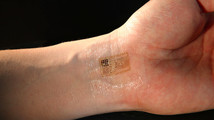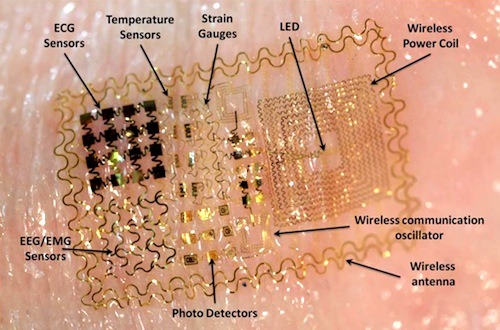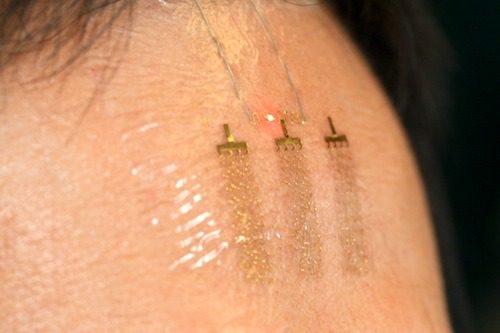/ News

Temporary tattoos could make electronic telepathy and telekinesis possible
Temporary electronic tattoos could soon help people fly drones with only thought and talk seemingly telepathically without speech over smartphones, researchers say.

Commanding machines using the brain is no longer the stuff of science fiction. In recent years, brain implants have enabled people to control robotics using only their minds, raising the prospect that one day patients could overcome disabilities using bionic limbs or mechanical exoskeletons.
But brain implants are invasive technologies, probably of use only to people in medical need of them. Instead, electrical engineer Todd Coleman at the University of California at San Diego is devising noninvasive means of controlling machines via the mind, techniques virtually everyone might be able to use.
His team is developing wireless flexible electronics one can apply on the forehead just like temporary tattoos to read brain activity.
“We want something we can use in the coffee shop to have fun,” Coleman says.
The devices are less than 100 microns thick, the average diameter of a human hair. They consist of circuitry embedded in a layer or rubbery polyester that allow them to stretch, bend and wrinkle. They are barely visible when placed on skin, making them easy to conceal from others.
The devices can detect electrical signals linked with brain waves, and incorporate solar cells for power and antennas that allow them to communicate wirelessly or receive energy. Other elements can be added as well, like thermal sensors to monitor skin temperature and light detectors to analyze blood oxygen levels.
Using the electronic tattoos, Coleman and his colleagues have found they can detect brain signals reflective of mental states, such as recognition of familiar images. One application they are now pursuing is monitoring premature babies to detect the onset of seizures that can lead to epilepsy or brain development problems. The devices are now being commercialized for use as consumer, digital health, medical device, and industrial and defense products by startup MC10 in Cambridge, Mass.

Electronic telekinesis? Digital telepathy?
In past studies, Coleman’s team found that volunteers could use caps studded with electrodes to remotely control airplanes and flew an unmanned aerial vehicle over cornfields in Illinois. Although the electronic tattoos currently cannot be used to pilot planes, “we’re actively working on that,” Coleman says.
These devices can also be put on other parts of the body, such as the throat. When people think about talking, their throat muscles move even if they do not speak, a phenomenon known as subvocalization. Electronic tattoos placed on the throat could therefore behave as subvocal microphones through which people could communicate silently and wirelessly.
“We’ve demonstrated our sensors can pick up the electrical signals of muscle movements in the throat so that people can communicate just with thought,” Coleman says. Electronic tattoos placed over the throat could also pick up signals that would help smartphones with speech recognition, he added.
Invasive brain implants remain better at reading brain activity, Coleman notes.
But neuroscientist Miguel Nicolelis at Duke University Medical Center says there is a need for noninvasive technologies such as these for the brain. “People will want to navigate environments just by thinking, or play games just by thinking,” says Nicolelis, who did not take part in this research.
Coleman detailed his group’s most recent findings in Boston on Feb. 17 at the annual meeting of the American Association for the Advancement of Science.

Top Image: Image of a piece of electronics with physical properties, i.e. stiffness, bending rigidity, thickness and mass density, matched to the epidermis. Such ‘epidermal’ electronic systems seamlessly integrate and conform to the surface of the skin in a way that is mechanically invisible to the user. The devices have the potential to provide a range of healthcare and non-healthcare related functions. Image courtesy John A. Rogers.
Middle Image: The Neural Interaction Lab led by UC San Diego bioengineering professor Todd Coleman is working with Mary J. Harbert, MD, director of neonatal neurology UCSD and Rady Children’s Hospital, to study the use of stamp-sized wearable patches of tiny circuits, sensors, and wireless transmitters to replace bulky wires currently used to monitor newborns in the neonatal ICU. The greatest advance in the neonatal ICU for premature babies has been stabilizing the heart and lung. But nowadays, experts are increasingly focusing on brain injury: under-development of the cerebral vasculature, hemorrhage, and seizures commonly occur in premies. If left unchecked, they can lead to epilepsy or cognitive development problems. Image courtesy Todd Coleman/UCSD.
Bottom Image: The Neural Interaction Lab led by UC San Diego bioengineering professor Todd Coleman is working with Ricardo Gil da Costa, PhD, at the Salk Institute to examine the use of wearable flexible electronics on the forehead to monitor congnitive impairment with systems that are minimally obtrusive. These patches of sensors monitor electrical rhythms of the brain and can wirelessly transmit information optically (via LEDs) or electromagnetically (via flexible antennas) to provide quantitative measures of attentional modulation that co-vary with the progression of dementia, Alzheimer’s disease, depression, and schizophrenia. These minimally obtrusive wearable electronics provide promise for future clinical brain monitoring applications for hospitals and laboratories, outpatient clinics or even at home. Image courtesy Todd Coleman/UCSD.
Source: http://txchnologist.com/post/43496630304/temporary-tattoos-could-make-electronic-telepathy
/ About us
Founded by Russian entrepreneur Dmitry Itskov in February 2011 with the participation of leading Russian specialists in the field of neural interfaces, robotics, artificial organs and systems.
The main goals of the 2045 Initiative: the creation and realization of a new strategy for the development of humanity which meets global civilization challenges; the creation of optimale conditions promoting the spiritual enlightenment of humanity; and the realization of a new futuristic reality based on 5 principles: high spirituality, high culture, high ethics, high science and high technologies.
The main science mega-project of the 2045 Initiative aims to create technologies enabling the transfer of a individual’s personality to a more advanced non-biological carrier, and extending life, including to the point of immortality. We devote particular attention to enabling the fullest possible dialogue between the world’s major spiritual traditions, science and society.
A large-scale transformation of humanity, comparable to some of the major spiritual and sci-tech revolutions in history, will require a new strategy. We believe this to be necessary to overcome existing crises, which threaten our planetary habitat and the continued existence of humanity as a species. With the 2045 Initiative, we hope to realize a new strategy for humanity's development, and in so doing, create a more productive, fulfilling, and satisfying future.
The "2045" team is working towards creating an international research center where leading scientists will be engaged in research and development in the fields of anthropomorphic robotics, living systems modeling and brain and consciousness modeling with the goal of transferring one’s individual consciousness to an artificial carrier and achieving cybernetic immortality.
An annual congress "The Global Future 2045" is organized by the Initiative to give platform for discussing mankind's evolutionary strategy based on technologies of cybernetic immortality as well as the possible impact of such technologies on global society, politics and economies of the future.
Future prospects of "2045" Initiative for society
2015-2020
The emergence and widespread use of affordable android "avatars" controlled by a "brain-computer" interface. Coupled with related technologies “avatars’ will give people a number of new features: ability to work in dangerous environments, perform rescue operations, travel in extreme situations etc.
Avatar components will be used in medicine for the rehabilitation of fully or partially disabled patients giving them prosthetic limbs or recover lost senses.
2020-2025
Creation of an autonomous life-support system for the human brain linked to a robot, ‘avatar’, will save people whose body is completely worn out or irreversibly damaged. Any patient with an intact brain will be able to return to a fully functioning bodily life. Such technologies will greatly enlarge the possibility of hybrid bio-electronic devices, thus creating a new IT revolution and will make all kinds of superimpositions of electronic and biological systems possible.
2030-2035
Creation of a computer model of the brain and human consciousness with the subsequent development of means to transfer individual consciousness onto an artificial carrier. This development will profoundly change the world, it will not only give everyone the possibility of cybernetic immortality but will also create a friendly artificial intelligence, expand human capabilities and provide opportunities for ordinary people to restore or modify their own brain multiple times. The final result at this stage can be a real revolution in the understanding of human nature that will completely change the human and technical prospects for humanity.
2045
This is the time when substance-independent minds will receive new bodies with capacities far exceeding those of ordinary humans. A new era for humanity will arrive! Changes will occur in all spheres of human activity – energy generation, transportation, politics, medicine, psychology, sciences, and so on.
Today it is hard to imagine a future when bodies consisting of nanorobots will become affordable and capable of taking any form. It is also hard to imagine body holograms featuring controlled matter. One thing is clear however: humanity, for the first time in its history, will make a fully managed evolutionary transition and eventually become a new species. Moreover, prerequisites for a large-scale expansion into outer space will be created as well.
Key elements of the project in the future
• International social movement
• social network immortal.me
• charitable foundation "Global Future 2045" (Foundation 2045)
• scientific research centre "Immortality"
• business incubator
• University of "Immortality"
• annual award for contribution to the realization of the project of "Immortality”.



 LinkedIn
LinkedIn
 LiveJournal
LiveJournal
 Google
Google
 Twitter
Twitter
 Facebook
Facebook
 Я.ру
Я.ру
 ВКонтакте
ВКонтакте
 Mail.ru
Mail.ru